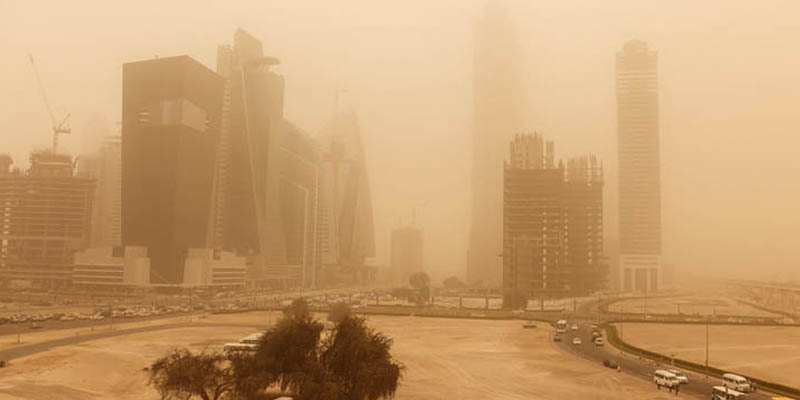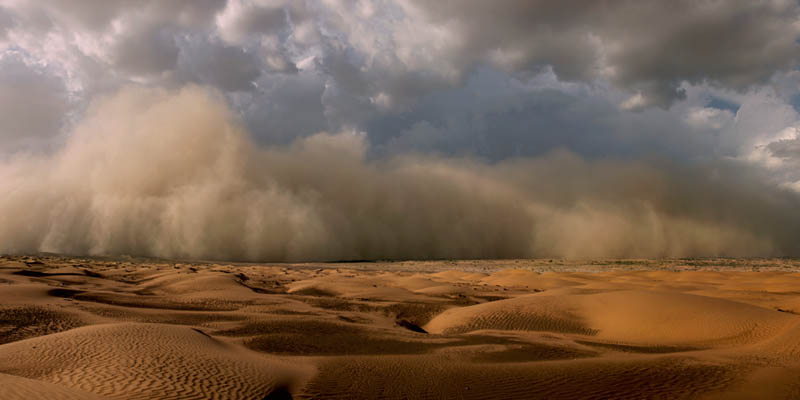Table of Contents
We explore sandstorms and explain their causes and effects. In addition, we discuss their characteristics, and provide examples.

What is a sandstorm?
A sandstorm is a meteorological phenomenon typical of arid and semi-arid climates. Sandstorms occur when intense winds lift large amounts of sand and dust forming a dense cloud that moves over the Earth's surface at high speed. These storms can last from a few hours to several days, often having a high impact on people's lives.
The sand and dust particles transported by the winds are very small and light. For this reason, they can reach heights of over 13,100 feet (4,000 m) and fly thousands of miles to very distant regions.
- See also: Thunderstorm
How do sandstorms form?

For a sandstorm to arise, a sufficiently strong wind that may lift dust or sand particles off the ground and send them into the atmosphere is required. As the wind advances and the cloud moves, more particles are incorporated, causing storms to grow in size and strength.
In addition to winds, droughts and lack of vegetation may also contribute to the formation and intensification of sandstorms.
Effects of sandstorms

Sandstorms can have extremely severe consequences for human populations:
- Visibility is reduced and the sky turns dark due to the amount of particles suspended in the air. This can increase the risk of traffic accidents and cause disruptions in road and air transport.
- Crops can be destroyed, affecting the food security of nearby communities.
- Interference can occur in radio signals and other means of communication, potentially hindering the work of emergency services in the affected areas.
- "Mud rain" or "rain dust" can originate, as suspended dust can mix with rainwater.
- Airborne dust transports minerals and materials to distant locations, affecting the chemical balance of other ecosystems.
- Dust can decrease the effectiveness of solar panels and similar solar energy technologies.
Difference between a sandstorm and a dust storm
Although they basically work in the same way, sandstorms and dust storms are distinguished by the type of solid materials they lift off the ground and throw into the atmosphere. Sand grains are larger in size than dust grains, lasting less time suspended in the air and flying shorter distances.
Another important difference is the height of the clouds. Sandstorms can create particulate clouds that rise several hundred feet off the ground, while dust storms generally produce lower clouds.
Sandstorms are more typical in arid and semi-arid regions, where large amounts of sand are available. In contrast, dust storms can occur anywhere, even in urban areas.
Sandstorm risk zones

Sandstorms are common in arid and semi-arid regions dominated by deserts, for example:
- in the Sahara Desert in North Africa
- in the Arabian Peninsula
- in the Gobi Desert in Mongolia
- in the Taklamakan Desert in northwest China
- in the Dry Pampas of Argentina
- in northern Chile
Sandstorm safety tips

In the event of a sandstorm, precautionary actions should be taken:
- Stay indoors. It is best to seek shelter indoors or in a locked vehicle.
- Cover your face. It is important to protect mainly the eyes, nose, and mouth.
- Stay hydrated. Sandstorms are typically very dry; it is therefore important to drink plenty of water to avoid dehydration.
- Avoid driving. If inside a car, the best thing to do is to stop and wait for the storm to pass, even if this results in being trapped inside the vehicle with virtually no visibility.
Sand and dust storm warnings
The World Meteorological Organization (WMO) develops a project for forecasting and alerting about sand and dust storms. To provide early warnings and accurate forecasts of sandstorms, the WMO works closely with national weather information services and international agencies that study climate.
Weather forecasts are based on the observation and analysis of meteorological information from satellite, radar, and weather station data. In addition, the WMO coordinates the exchange of meteorological information between countries, a fundamental step in attempting to forecast the occurrence of large sandstorms that may affect several regions.
Worst sandstorms in history
Some of the most severe sandstorms in recorded history occurred in:
- Sydney, Australia, 1942. It was the biggest dust storm in the city's history, reducing visibility at the local airport to 1,640 feet (500 m).
- Phoenix, US, 2011. The entire city was covered by a dust cloud of 9,840 feet (3,000 m) high and 50 miles (80 km) wide that halted all flights to and from the city.
- Beijing, China, 2014. It was one of the worst dust storms in the region, forcing schools to close and causing damage to the infrastructure of cities. In addition, it affected Tianjin and Zhengzhou.
- New Delhi, India, 2018. Over 125 people were killed when a dust and sand storm struck during the night, causing a large number of buildings to collapse.
Sandstorms outside of Earth
Sandstorms are relatively common events on Mars, where they can last for weeks or even months. They occur when Martian winds lift large amounts of dust and sand off the planet's surface and throw them into the atmosphere.
These storms can also impact space exploration. During a sandstorm, incoming sunlight and surface visibility are significantly reduced, which can hinder the operation of spacecraft that operate and collect data using solar energy.
Explore next:
Was this information useful to you?
Yes NoThank you for visiting us :)